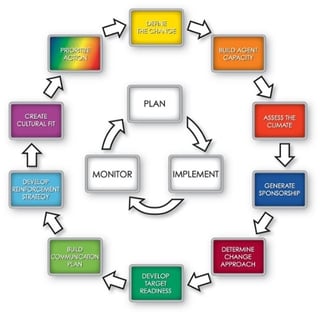No behavior change, no implementation. It’s a simple, but profound statement about the criticality of the human side of business projects, including transformational change initiatives. Right from the start, project teams must take a purposeful approach to identifying what the new behaviors are for the transformation. It’s why a foundation of IMA’s proprietary Accelerating Implementation Methodology (AIM) is, “In order to achieve value realization, you must first identify the “human objectives” for your change.” 
But what exactly are the “human objectives” and why is it so important to pay attention to them?
Simply put, they are the observable, behavioral impacts of the change. Even if you have business measures identified like improvements in productivity, or reduced waste, or improved quality, you can’t actually achieve them without some type of behavior change. In the end, you can install new systems and processes all day long, but nothing will really change unless behaviors change!
Define the Change in Human Behavior
Full “implementation” can only be gained when we define the behaviors associated with the change. In other words, what will people actually be doing differently as a result of the change, and how will you “know it when you see it?”
Sometimes it can be difficult for Change Agents to understand what these new behaviors will look like. Try imagining it is some time in the future, and you walked into the organization. What would you see people doing that is different from what they are doing today?
But remember, as the change is rolled out you need to make sure the human objectives are defined for every Target audience that is impacted by the change. There will be behavioral impacts at the program level, but there will also be behavioral impacts for each workstream. All need to be identified! This is why the program’s charter is insufficient in detail and scope from the human perspective. Realistically this is an ongoing process, because you won’t have the level of detail needed right at the start of project initiation.
What’s Next?
Let’s assume then, that you know what the new behaviors are that you are seeking. How do you then get people motivated to change and adopt these new ways of working? It’s not easy to get people to leave the comfort of the “status quo” and move to the unknown! And transformation, by definition is a radical leap where you can’t turn back.
 It takes reinforcement, including positive rewards, negative consequences, and a plan for making the new ways of working easier than maintaining the status quo. Rewards are more powerful than negative consequences, but a mixture of both is needed. These rewards must be in the “Frame of Reference” of the people who you want to change, and must be radically different from the present in order to drive transformation.
It takes reinforcement, including positive rewards, negative consequences, and a plan for making the new ways of working easier than maintaining the status quo. Rewards are more powerful than negative consequences, but a mixture of both is needed. These rewards must be in the “Frame of Reference” of the people who you want to change, and must be radically different from the present in order to drive transformation.
The best and fastest way to apply the reinforcement is through the boss of the individual who needs to change in some way. These “bosses” are all “Reinforcing Sponsors” of the transformation. So, new behaviors are identified, reinforcements are planned by Change Agents and Sponsors working together, and then the reinforcements are executed by the Sponsors with their direct reports. It’s a systematic approach that drives the behavioral changes directly to those individuals who are impacted in some way.
AIM: A Repeatable Change Process
We know that business transformation will not be achieved or sustained for the long haul unless we pay attention to how the changes impact each individual. Addressing the human factor is a must-do, and it is not about getting people to like the change by communication alone. AIM provides the structure needed to replicate the human change process across functions, geographies, power structures, and cultures: 
- Define the Change- To measure whether you’re achieving the human elements of change you need to first define the behaviors you want to see. How are people behaving now and how do you want them to behave after the change?
- Generate Sustained Sponsorship- A cascade of committed Sponsors is the most critical factor in implementation success and speed. Sponsors must Express, Model, and Reinforce commitment to the change.
- Develop Reinforcements for Change- Managers should reinforce very early on the new behaviors, and publicly recognize the "early adopters."
Accelerating Implementation Methodology (AIM) allows you to manage the human side of transformational change practically, systematically, and with rigor and discipline. Without the behavior change, there is no transformation!


